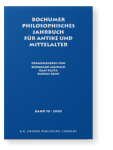Zum Begriff der formalen und materialen Folgerung
Richard Billingham und die englische Tradition des 14. Jahrhunderts
The theory of consequences was one of the most important developments in logic during the Middle Ages. The distinction between formal consequences (consequentiae formales) and material consequences (consequentiae materiales) was probably introduced by Ockham and soon became the main division of consequences, to be found in nearly all 14th-century treatises on the theory of consequences. This paper discusses the concept of a formal and material consequence according to the English tradition (which differs from the continental tradition). It is based mainly on Richard Billingham’s De consequentiis, but also takes into account other 14th-century authors. Billingham defines the formal consequence as one where the consequent is understood in (intelligitur in) the antecedent and differentiates this kind of consequence from the material one. The definition is followed by a list of rules for valid consequences. However, with respect to some of these valid consequences the question arises whether they are formal or not and, if they are formal, how it is possible to explain the criterion of the intelligitur in. After explaining the material (part 2.1) and the formal consequence (part 2.2) and discussing these difficulties, the question is raised whether the intelligitur in is an appropriate structural criterion to distinguish between formal and material consequences (part 2.3). Finally, two interpretations for the intelligitur in compatible with the text situation are proposed.
Article language: German
